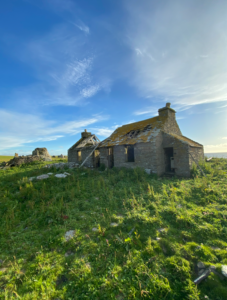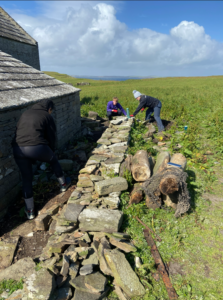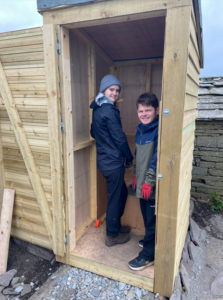
The tiny Orkney Island of Swona was abandoned in 1974, leaving only a small herd of feral cattle to roam the 92 acres.
The ten Year 12 students and two school staff spent eight days on the island restoring much of the infrastructure – and even built the island’s first toilet in half a century.
They stayed in an abandoned house unlived in for a century and learned how to catch fish off the North Head of the island, baked their own bread on an open fire and even had to pump fresh water from a 1,000-year-old well.
The students worked with the owners of the island – descendants of the last people to live there – to rebuild the old pier, paths and stone dykes and make one of the old cottages habitable.
They spent a marathon ten hours going by bus, ferry and boat to reach the remote island, situated in the Pentland Firth, around seven miles north of John o’ Groats.
Gordonstoun’s is renowned for its Hahnian education, developing compassion and resilience through challenge and commitment to the service of others. Senior students also embarked on charity projects to Thailand, Romania and India to work with local communities.

“Swona has thousands of years of human history, including Viking Farms, Neolithic tombs and a Medieval chapel, before the last inhabitants left in 1974. The island has effectively been cut off from the world with just a herd of cattle roaming feral for the past 50 years.
“When I first explained to the students, we would have to source our own water and that we would be staying in a cottage that had been unoccupied for 100 years, some of them had a little bit of trepidation about going on the trip. However, their spirit for adventure soon kicked in when they realised we would be making a bit of history by being the first group to return to the island in half a century. We were also well equipped, bringing seven large boxes of provisions with us. We had to be self-sufficient for more than a week which meant bringing everything from dry foods, sleeping bags, building supplies and equipment. We had no fridge so we had to be creative about what foods to bring with plenty of supplies of foods that could be rehydrated, including chicken for a stir fry.”
The Gordonstoun team travelled to the island in June and worked with the Annal family, the descendants of James and Violet Rosie and the last inhabitants, to restore the remaining infrastructure, building a toilet, restoring slate paths and stone dykes, concreting the old pier and refurbishing the former croft cottage of Norhead.

“The trip to Swona was absolutely life-changing, it was a great opportunity to learn new life skills on a remote island while making new friends. There was a great camaraderie and a real sense of achievement by being of service to the local community. I wouldn’t have changed it for the world.”
Principal Peter Green said:
“Gordonstoun is renowned the world over for its unique approach to education, offering our students challenging opportunities outside the classroom to help others. Spending more than a week on one of the remotest parts of the country was a major test for the children, but one which they grabbed with both hands. Like our founder Kurt Hahn, I firmly believe that students need to encounter ‘Challenge’ in all that they do, as part of their commitment to the service of others. Taking them out of their comfort zone develops resilience, fortitude and important life skills.”

Swona is a Site of Special Scientific Interest (SSSI) due to its rare vascular plants, but it is also an important breeding colony for many species of seabird, particularly the Arctic Tern, Puffins and Razorbills. It is also known for its Orcas, Dolphins, Pilot Whales and Minke Whales.
William Annal said:
“The Gordonstoun students put in a tremendous effort and were a huge benefit to the built and natural heritage of the island, reversing many years of decay. Their presence and personality breathed life and energy back into the island that hasn’t been seen in 100 years and it was tremendous to see. The work has progressed the goals of the Swona Heritage Group by many years.”

“We were the largest community on the island since the 1920s. For the first time in many decades the fields and houses of Swona echoed to the sound of conversation, laughter, and music, including tunes composed on the island by one of our students. The students of Gordonstoun’s first Swona Service Project were mesmerised by their experience, learning a great deal about themselves and their abilities as well as about the island and its history. Their work will allow greater access to the island for those interested in its natural riches and its unique heritage. The project was such a success that we now plan to make an annual trip to Swona. We hope that many generations of Gordonstoun students will benefit from the opportunity to contribute to the restoration of such an inspiring and historic location. Future groups will not only continue the ecological and heritage work begun this year but will also begin to assess the archaeological potential of the island, until now untouched. We will be working with professional archaeologists from University of Highlands and Islands to find out more about the island’s heritage.”


